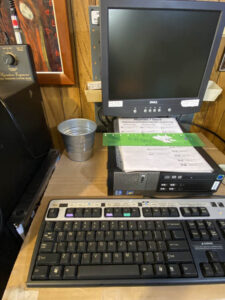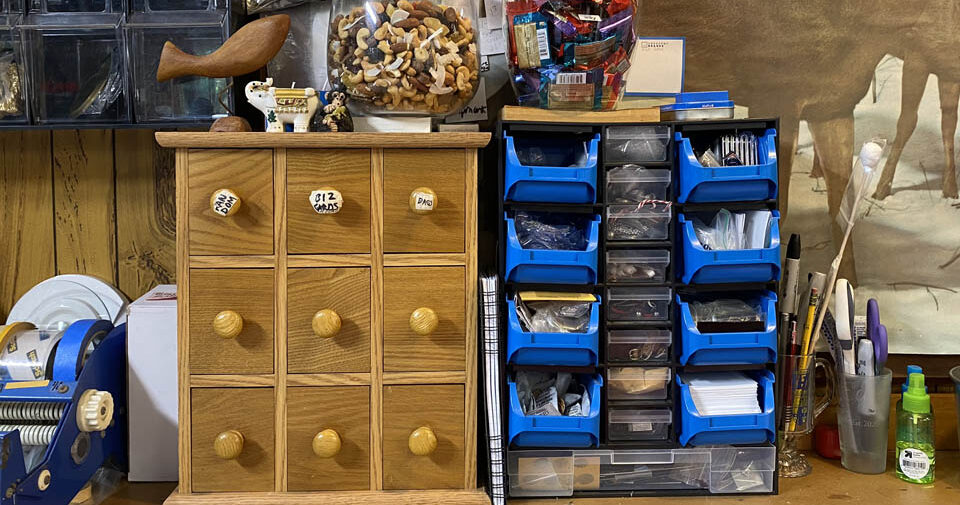I grew up a total slob. Just ask my mother. I lived in utter chaos for years. Crunched-up school assignments, piles of clothes, and the occasional half-eaten candy bar. Even my best friend referred to my college car as, “The Traveling Dresser.” Organization was not my strength until one day a light bulb went on. In need of preparing a gift for a friend’s birthday, I spent more time careening through the chaos looking for the scissors, tape, and wrapping paper than I did actually wrapping the gift. Something had to change.
Today, having a busy shop in a 24′ X 24′ space full of power tools and engraving machines, I have learned to keep the clutter down, and still have a good idea of where things are. I have learned to consolidate and keep my sanity through thoughtful organization.
The process was done in four steps: Get rid of unnecessary stuff, create space, clean areas, and finally, keep it organized.
Get rid of unnecessary stuff
Admit to yourself: You are never going to finish that project that is sitting in the corner. Twenty-three generations of spiderwebs should be enough to convince you of that. And the wood from the palate that you dismantled 15 years ago when you got your first laser, that must go away, too. Check the floors and corners of your shop. If the dust on items is older than the ketchup in your refrigerator, get rid of it.
Next, it is time to move up to your desk and workbench. The rule for my workbench: if I don’t touch it monthly, it goes away. Harsh, but helpful. If I touch it weekly, then it should be out and accessible. This includes tape, a tiny trash can, a small spray bottle of 90% alcohol, magnifiers, and a big jar of chocolate. Anything small that I touch monthly is in drawers and bins against the wall, protruding no more than 8″. These include perpetual plates, nametag magnets, small scratch paper, clips, nuts, rods, and other assorted items I need periodically during the month. Regularly used electric tools, like the battery-powered drill and heat gun are also in this area. Regularly used hand tools are on a 16″ magnet affixed to the wall above. Just the basics. Check in every few months — are you still using everything regularly? Times change, machines get updated, tools evolve. Do you still need all those items?
My desk is more strict. It is small and therefore limited. Computer accessories are unavoidable. Two screens are heavenly. Calipers, JDS 6″ rulers, pens, pencils, markers, and scissors all must fit into the coffee cup. A small stack of Post-it Notes can sit on the desk. A razor blade and a 36″ tape measure live under the two computer screens with a tiny restaurant-size jelly jar (1.5″) that I keep as a trash bin for pieces of tape and staples. Finally, my water cup. Without hydration, I am grumpy! Nothing else goes on my desk unless I am currently working on it.
All of us have at least one coffee mug that holds pens and pencils, etc. Dump out everything, and test all writing instruments. If they don’t work, get rid of them. If your sharpies don’t work, spray the tips with rubbing alcohol. It will revitalize them. Get rid of the stubby pencils; you can afford new ones. Get rid of anything else that does not serve a purpose. If your scissors are dull, get them sharpened. We have a guy we see every week at the farmer’s market.
Create space
Take another look around. What space is unused or poorly used? Is there a shelf under your worktable that has 2′ of vertical space, but you are only using half of it? Add a shelf. Same with the closet. Add shelves wherever you can. Stack bins on shelves to use the space more efficiently. You can find rolling sets of drawers and bins inexpensively at flea markets and garage sales.
Shop going-out-of-business sales for other maker-shops — frame shops, sign shops, lawnmower repair shops — you never know what kind of cool storage units you might find. At one sale I went to, I found a four-level revolving tray. This sits proudly in the corner of my workbench. I could not possibly reach all the way back there, but with the revolving tray, I have four levels of revolving access.
 Floor space is also important. Trash cans can be tripping hazards. Strategically placed and easily accessible bins are essential. I have a rolling set of metal baskets. The lowest slide-out holds my recycling and trash containers. The bins are the size that would normally be under the desk. The drawer can be opened or closed, and the bins stay out of the way.
Floor space is also important. Trash cans can be tripping hazards. Strategically placed and easily accessible bins are essential. I have a rolling set of metal baskets. The lowest slide-out holds my recycling and trash containers. The bins are the size that would normally be under the desk. The drawer can be opened or closed, and the bins stay out of the way.
On the workbenches and near machines, I have small 6″ metal buckets. Most of my trash is in small pieces (tape backing, peeled film, tissues) and these tiny buckets take up minimal space and don’t get underfoot. In the middle of the room are two kitchen-sized bins that the others are dumped into. They generally don’t move, and thus are not in the way.
Finally, the plague of the empty boxes. I ship about once a month, and have no need for all the boxes I receive product in. But, I have found a company that ships a lot. They get all my boxes and packing material. I get the satisfaction of keeping them out of the landfill for now.
Despite what you are reading, I am not a fan of Spartan workrooms. Your workspace should reflect who you are. I fill my walls with memories — an extra Santa ornament from the big order 5 years ago, a stress toy that is shaped like a brain, the last cool Cracker Jack prize I got. But there is no need for any of these memories to be on my workspace. I plan to add a long shallow shelf near the ceiling for all those mementos. Up top and out of the way.
Clean up
Ok, you got rid of the junk, you’ve increased your storage space, now it is time to clean up!
I know — an unsurmountable, monumental task, but not if you break it up. Start with the items that you removed from the workbench, but that you will still use from time to time. Wouldn’t it be great if the last place you look for something was actually the first place you look? Hold a homeless item in your hand. Ask yourself, “Where is the first place I would look for this?” That is where it should be stored. And those areas should be categorized. Under one of my tables I keep all things that bind — clamps, glues, and tapes. In another area I have paint supplies — brushes, drop cloths, and paint can keys. Find overall categories. Keep stuff together.
 A little cleaning every day can lead to a lot of clean areas in a month! 30 minutes each day — maybe less!
A little cleaning every day can lead to a lot of clean areas in a month! 30 minutes each day — maybe less!
Start with something easy. Clean up all those Post-it Notes around your screen. I consolidated scores of them in a CorelDraw file and printed out the ones I need most onto a single strip of paper that hangs on either side of my screen — favorite fonts, conversions, settings, alt keys, and a Mohs scale.
Next, start on the shelves, any shelf. Do one shelf per day. Remove everything, dust it, and replace items in a more organized manner. Relocate or trash items you don’t use. If you use multiple items at the same time for a given project, such as rods, nuts, trim, and figures for building trophies, keep them stored together.
Keep it organized
The key to not having so much stuff is to not acquire so much stuff. I used to go to trade shows and marvel at the new items. “I’ll take two of those and six of those.” STOP! Take pictures. Save them to Evernote or a folder on your computer. Need what you have and have what you need. Ease up on your tradeshow acquisitions.
Take inventory. Really. Or better still, pay someone else to come in and do it. It will be worth the investment. Make an Excel spreadsheet. List the year each item was purchased, and from what company, price at that time, current price, description, item number, and, most importantly, location. Number your storage shelves. If a client comes in and wants a $100 item, you can sort the spreadsheet by price, and quickly find those items. This is much easier than searching everywhere! Remember to put things back where you found them.
One last suggestion: Always put things away before you leave in the evening. Leave a clean, clutter-free workspace and desk for the next morning. Start your new day ready to rock and roll, not riffle through yesterday’s remains.
Decluttering does not have to be a chore. Each step you take brings you farther away from chaos and adds time to your life by knowing where items are located. It will take 30 seconds or less to put something away. It can take 30 minutes or more to search for it in chaos. The choice is yours.







